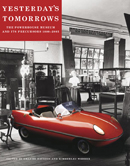
The Strasburg Clock 'still dazzles and intrigues visitors to the Powerhouse Museum where, for over a century, it has been among the most popular exhibits'. Its ingenious builder, Richard Smith, left little 'messages for posterity' engraved within its elaborate mechanism. 'Here', as Graeme Davison eloquently observes, 'inside its beautiful case, invisible to the casual onlooker, the old clockmaker remains in charge of his clock'. It is the privilege of museum curators to transform the visitor from casual onlooker to knowing observer, to take them on a journey through and around objects in ways that reveal and translate the hidden messages. It might be said that the Powerhouse Museum, indeed any museum, is not unlike Smith's elaborate timepiece in its complexities, its intricacies, its idiosyncrasies, and its 'messages for posterity'. As such, museums pose singular challenges for the historian: how can a mere book even begin to capture the experience that is, and has been, a museum? Yesterday's Tomorrows: The Powerhouse Museum and its Precursors 1880-2005, in breaking with the 'institutional, chronological tradition of museum history', goes a long way towards answering that question.
Museums cannot escape history, and for all their concentration on the object, on visual display, neither can they escape words. There is a long tradition in museology of an assault on words. Every generation seems to have considered that the labels of the previous era were too wordy, none more so than the most recent - as if objects could somehow explain themselves, and the average visitor had the attention span of a gnat. The sight of enthralled crowds gathered around the volunteer 'explainer' in front of an exhibit or model suggests otherwise. Yesterday's Tomorrows is conceived with that crowd in mind. It is significant that while the Powerhouse Museum has a Board of Trustees, 'Trustees' does not appear in the index. It is not that their decisions or their struggles to maintain and develop the museum are absent from this history, only that the outcomes of their activities are its central focus. Curators and other staff are richly present, not just as historical subjects but as authors. They keep company with established historians, whose knowledge of their subject areas is deep and broad.
The opening section, 'Three Days in the Life of a Museum', is a deft and evocative solution to setting out the chronology and the drama of the museum's history and its Sydney context. More than an introduction, it provides a scaffold reaching around to the concluding section which brings coherence to the intervening essays. It also allows them a measure of economy in dealing with the larger institutional history, thus making for lively and engaging writing.
Section 1, 'Visions', is a series of thematic essays. With titles such as 'exhibiting', 'empowering' and 'imagining', they are provocative, engaging and deep explorations of the museum's aspirations and achievements in education, public health and safety, research, and applied art and design from 1880 to the present. They are complemented in section 2 by a series of representative case studies of the museum at work. Here are essays to enchant the serious devotee of technology museums: about clocks and steam engines, sheep breeding, the pioneers of flight and computers. These are, however, more than good stories, they are good history. Like the thematic essays, they offer interpretation and commentary related to wider historical and museological discourse in Australia. In revealing just how much vibrant social, political and economic history is embedded in the objects, collections, documents and individual biographies, these stories stand as salutary lessons in the need for caution in the face of a long-standing tendency of technology museums to deaccession the apparently obsolete. Oddly, there is little extended treatment in this section of the applied art and design collections. They appear rather as decorative interludes, inadvertently perhaps perpetuating an unfortunate cultural divide between (decorative) arts and (useful) sciences and technology.
Section 3, 'Tomorrows', attends principally to the relationships between buildings and function and between the museum and the community it serves and represents. It reveals as much about Sydney as it does about modern museum design and the transformation of the Ultimo Power Station into a museum in 1988. The complex treatment of issues of heritage, architecture and town planning and the way these influence the experience of place is unexpected and fascinating. It succeeds in giving the buildings something of the same vibrant presence in the history that they exert in real life.
Yesterday's Tomorrows makes no claims to be comprehensive; rather it seeks to add meaning and depth to the contemporary experience of museums, confident in the role that the insistent intrusion of social history into museums of applied science has played in their revitalisation. This is a history to take home after visiting the Powerhouse Museum and dip into over and over again to enrich and deepen in tranquillity the recollection of that hectic and deliciously exhausting experience. Full of 'messages for posterity', Yesterday's Tomorrows is a luxuriously illustrated history which adds multiple layers of meaning and story to a collection that is too large and complex to appreciate fully in one or two visits.
